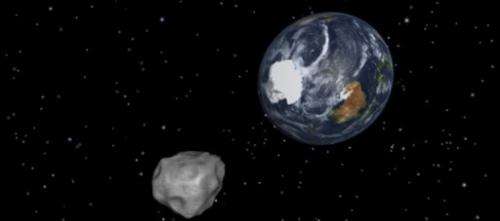Time for Europe to beef up asteroid vigilance, ESA says

Europe must strengthen its watch for dangerous space rocks, the head of the European Space Agency's asteroid surveillance programme said Thursday, a week after a meteor struck Russia in a blinding fireball.
Nicolas Bobrinsky, in charge of ESA's four-year-old Space Situational Awareness (SSA) programme, said his unit would inaugurate a centre in Rome on May 22 to coordinate observatories' sightings of passing asteroids.
The SSA is also working on a prototype "fly's eye" telescope, with specially-designed wide vision, to help surveillance of the cosmos, he said.
But Bobrinsky said this was not enough, given the risk from smaller asteroids of the kind that exploded over the central Russian city of Chelyabinsk last Friday, injuring more than 1,200 people.
He called for help to build an automated network with six such telescopes so that the night sky would be scrutinised around the world.
"The fact that we are pursuing this programme is very satisfying, but the take-home message is that we have to step up our efforts so that the necessary protection is put in place," Bobrinsky said.
Such a network could give three months' warning of a dangerous asteroid, "enough to evacuate a threatened region if necessary or possibly launch a mission to change (the asteroid's) trajectory," he said in a phone interview.
The Chelyabinsk rock is estimated to have been 17 metres (56 feet) across.
It struck just hours before a 45-metre asteroid, 2012 DA 14, skimmed past the Earth at a distance of about 27,000 kilometres (7,200 miles)—the closest ever flyby by any predicted object.
Thanks to a NASA-led programme, astronomers are making headway in identifying very large asteroids measuring a kilometre or more across that may stray into our neighbourhood.
"Around 99 per cent of these big asteroids have already been spotted," Bobrinsky said.
"The real danger now comes from small asteroids, which are far more numerous," he said.
Around a million asteroids measuring 50 metres (165 feet) or more orbit the Sun, said Bobrinsky.
How many of them are "geo-cruisers," meaning that they come close to the orbit of the Earth, is unknown. So far, fewer than 10,000 asteroids in this category have been detected, he said.
"Most of the objects that may one day pose an impact risk have not been detected," said Bobrinsky. "There is a colossal amount of work to be done."
The SSA has a five-million-euro ($6.6-million) budget throughout 2013-2016, with which it has to monitor space storms and orbital debris as well as track asteroids.
(c) 2013 AFP





















